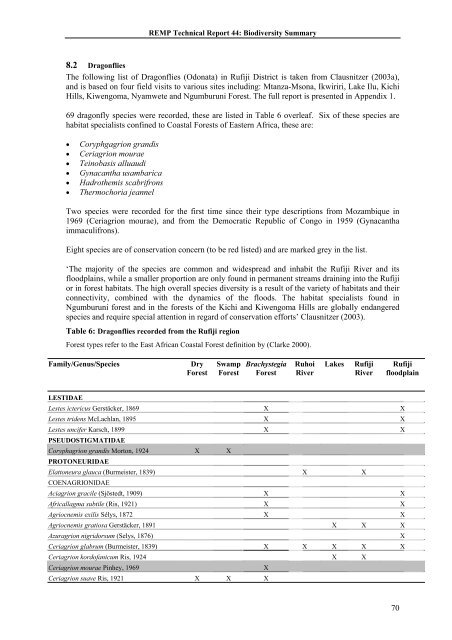Family / Scientific name - Coastal Forests of Kenya and Tanzania
Family / Scientific name - Coastal Forests of Kenya and Tanzania
Family / Scientific name - Coastal Forests of Kenya and Tanzania
Create successful ePaper yourself
Turn your PDF publications into a flip-book with our unique Google optimized e-Paper software.
REMP Technical Report 44: Biodiversity Summary<br />
8.2 Dragonflies<br />
The following list <strong>of</strong> Dragonflies (Odonata) in Rufiji District is taken from Clausnitzer (2003a),<br />
<strong>and</strong> is based on four field visits to various sites including: Mtanza-Msona, Ikwiriri, Lake Ilu, Kichi<br />
Hills, Kiwengoma, Nyamwete <strong>and</strong> Ngumburuni Forest. The full report is presented in Appendix 1.<br />
69 dragonfly species were recorded, these are listed in Table 6 overleaf. Six <strong>of</strong> these species are<br />
habitat specialists confined to <strong>Coastal</strong> <strong>Forests</strong> <strong>of</strong> Eastern Africa, these are:<br />
�� Coryphgagrion gr<strong>and</strong>is<br />
�� Ceriagrion mourae<br />
�� Teinobasis alluaudi<br />
�� Gynacantha usambarica<br />
�� Hadrothemis scabrifrons<br />
�� Thermochoria jeannel<br />
Two species were recorded for the first time since their type descriptions from Mozambique in<br />
1969 (Ceriagrion mourae), <strong>and</strong> from the Democratic Republic <strong>of</strong> Congo in 1959 (Gynacantha<br />
immaculifrons).<br />
Eight species are <strong>of</strong> conservation concern (to be red listed) <strong>and</strong> are marked grey in the list.<br />
‘The majority <strong>of</strong> the species are common <strong>and</strong> widespread <strong>and</strong> inhabit the Rufiji River <strong>and</strong> its<br />
floodplains, while a smaller proportion are only found in permanent streams draining into the Rufiji<br />
or in forest habitats. The high overall species diversity is a result <strong>of</strong> the variety <strong>of</strong> habitats <strong>and</strong> their<br />
connectivity, combined with the dynamics <strong>of</strong> the floods. The habitat specialists found in<br />
Ngumburuni forest <strong>and</strong> in the forests <strong>of</strong> the Kichi <strong>and</strong> Kiwengoma Hills are globally endangered<br />
species <strong>and</strong> require special attention in regard <strong>of</strong> conservation efforts’ Clausnitzer (2003).<br />
Table 6: Dragonflies recorded from the Rufiji region<br />
Forest types refer to the East African <strong>Coastal</strong> Forest definition by (Clarke 2000).<br />
<strong>Family</strong>/Genus/Species Dry<br />
Forest<br />
Swamp<br />
Forest<br />
Brachystegia<br />
Forest<br />
Ruhoi<br />
River<br />
Lakes Rufiji<br />
River<br />
Rufiji<br />
floodplain<br />
LESTIDAE<br />
Lestes ictericus Gerstäcker, 1869 X X<br />
Lestes tridens McLachlan, 1895 X X<br />
Lestes uncifer Karsch, 1899 X X<br />
PSEUDOSTIGMATIDAE<br />
Coryphagrion gr<strong>and</strong>is Morton, 1924 X X<br />
PROTONEURIDAE<br />
Elattoneura glauca (Burmeister, 1839) X X<br />
COENAGRIONIDAE<br />
Aciagrion gracile (Sjöstedt, 1909) X X<br />
Africallagma subtile (Ris, 1921) X X<br />
Agriocnemis exilis Sélys, 1872 X X<br />
Agriocnemis gratiosa Gerstäcker, 1891 X X X<br />
Azuragrion nigridorsum (Selys, 1876) X<br />
Ceriagrion glabrum (Burmeister, 1839) X X X X X<br />
Ceriagrion kord<strong>of</strong>anicum Ris, 1924 X X<br />
Ceriagrion mourae Pinhey, 1969 X<br />
Ceriagrion suave Ris, 1921 X X X<br />
70

















